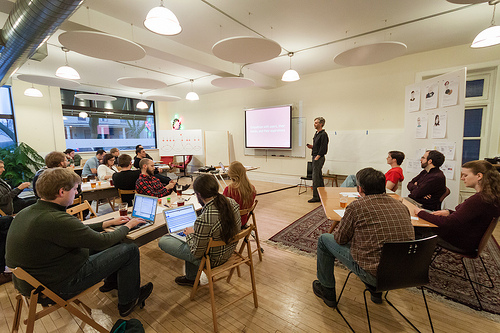One of the things I’ve missed during the pandemic is the opportunity to meet and collaborate with fellow designers and product thinkers at conferences and workshops. Over the years, I’ve been challenging myself to participate in these events not just as an observer, but also as a presenter and speaker.
I’ve found speaking to be a wonderful way to dig deeply into a slice of our vast design discipline. I love the way audience questions push me to think about our craft and my assumptions. And I’ve met some amazing speakers, event organizers, and designers along the way.
Today, I’d like to share a few things I learned along the way (and some I wish I’d known when I started out).
Choosing a Topic & Method
The most important advice I can give you is to present on something you love or are interested in talking about. Even if it takes a bit more research upfront as you write the talk, you will find more joy in the process of crafting and refining the presentation. I’d also recommend starting small with something that you can speak confidently to, such as a case study or specific design best practice.
Consider whether you want to give a lightning talk, a presentation, a workshop. I think lighting talks are a great place to start. Not only are they short (typically 7-15 minutes), but they also provide the challenge of communicating a cohesive message in a limited amount of time. I’ve also found that lightning talks are a great way to test out a talk idea before committing to a longer 30- or 60-minute presentation. While some conferences (such as our local event Ignite UX) focus on lightning talks, others offer a lightning round as part of their program.
Finding a Place to Present
 I started out speaking at local UX or Design organizations and meetups. How do you get selected for this kind of talk? Ask an organizer if they’re looking for someone to give a short presentation or case study. It’s usually that simple. As an organizer for our local Ladies that UX branch, I was frequently looking for speakers for monthly meetings. I would’ve welcomed volunteer speakers! This option is also nice for those who prefer a more conversational style of presentation.
I started out speaking at local UX or Design organizations and meetups. How do you get selected for this kind of talk? Ask an organizer if they’re looking for someone to give a short presentation or case study. It’s usually that simple. As an organizer for our local Ladies that UX branch, I was frequently looking for speakers for monthly meetings. I would’ve welcomed volunteer speakers! This option is also nice for those who prefer a more conversational style of presentation.
You can also choose to speak at annual, scheduled conferences. While large, well-known conferences may have more competition for a speaking slot, local conferences (such as your local WIAD) tend to have a smaller pool of applicants. I found it was helpful to start local and work my way up to larger conferences.
Remember that you can submit a talk that you haven’t written yet! If you have an idea that you are passionate and knowledgeable about, you can submit a talk proposal and then write the talk after it’s accepted. Just remember not to make the proposal too specific so that you have some wiggle room when writing your talk.
Preparing & Practicing
Once your talk is accepted, the real work starts. Be sure to thoroughly research your topic. Think about the best way to present your idea: is it better to present it through the context of a case study or narrative, or is it better served as a three- or five-part argument? If you are unsure how to get started on writing a talk, I recommend finding workshops/seminars on the subject or taking a class on public speaking.
 Once you’ve written your presentation, the old adage holds true: Practice makes perfect! When I started giving talks, I thought it was enough to run a few practice presentations in front of the dog (my number one, most inpatient fan) and check the overall time.
Once you’ve written your presentation, the old adage holds true: Practice makes perfect! When I started giving talks, I thought it was enough to run a few practice presentations in front of the dog (my number one, most inpatient fan) and check the overall time.
Since then, I’ve learned it’s important to practice talks in front of humans — preferably those who understand a little about your domain. Ask them what they learned from the talk and what they thought you were trying to convey. Also ask for specific feedback, especially about your presentation cadence and any areas where you feel uncertain.
I can’t stress enough how important it is to practice in front of a variety of people, both to get their feedback and to get familiar with your presentation and content.
Presenting
You made it! Today is the big day. Hopefully, you have practiced your talk enough that you are confident and can remember what you wanted to talk about in the event your notes or presentation slides aren’t available due to technical difficulties. (I’ve had this happen more times than I can count!)
Even if you are nervous, be sure to eat your usual meals, drink water, and wear something comfortable to present in. My top tip is to eat a small carb like a few raisins or M&Ms before you present. The sugar will help hold off the shakes and jitters until after your talk.
No matter what happens, you should be proud of yourself for putting yourself out there. Remember: no one remembers your mistakes, except for you. :)

Don’t Stop There!
Once your talk is complete and you have basked in the relief of completion, take a moment to reflect on your talk. If possible, ask friends or colleagues from the audience what they thought. Did they find the talk useful?
Consider expanding the talk and giving it at additional venues. I was surprised to learn that many people who give talks continue to expand and iterate on a single talk over multiple conferences. It makes sense; we iterate on our designs, why wouldn’t we iterate on our talks? You can also iterate on a talk by discussing it in different formats. For example, a concept could look very different as a lightning talk, a thirty-minute talk, and a workshop.
In all, pushing myself to speak at conferences and local meetups has helped me meet wonderful designers and learn more about design. I hope these tips and anecdotes help as you consider your own journey as a presenter and speaker.

